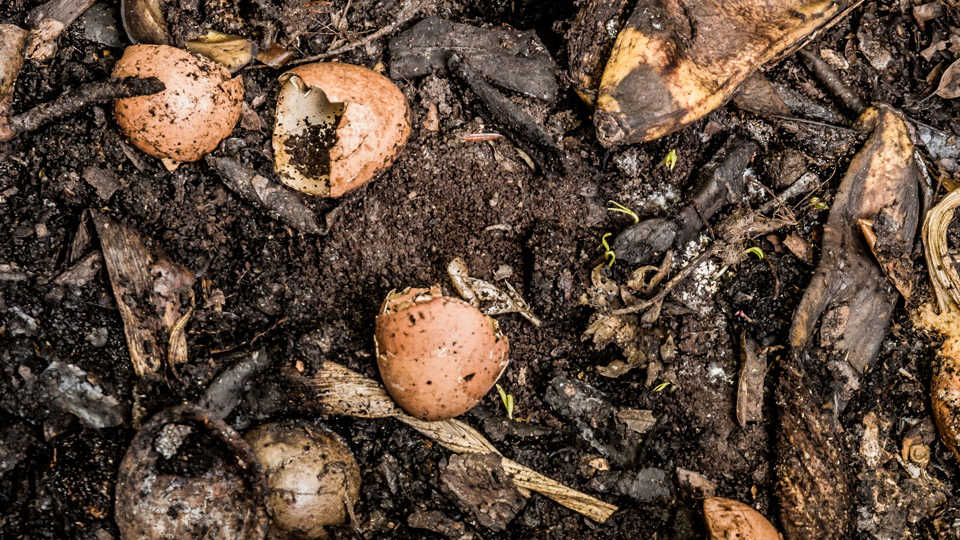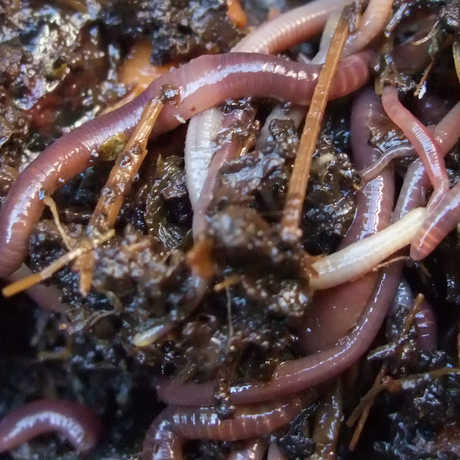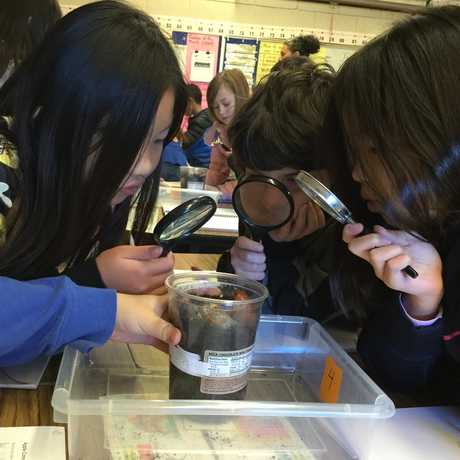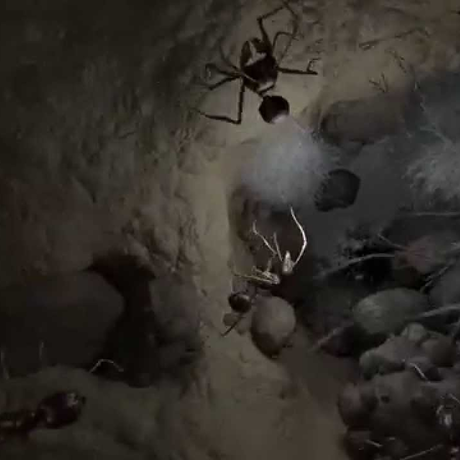
"Compost" © 2014 Philip Cohen
In this two-part inquiry-based activity, students will practice using the scientific method while learning about decomposition, exploring how some types of garbage will decompose while others will not. Students can then go on to design their own experiment to test different variables affecting the rate of decomposition.
In this lesson, students will:
- learn that trash is composed of two types of waste: organic and inorganic.
- learn the different between a full-loop life cycle and a linear life cycle.
- learn that decomposers such as fungi, microorganisms, and insects are important in the decomposition of organic waste.
- practice asking scientific questions.
- gain experience designing an experiment to answer a question.
- 6 clear jars
- At least one “set” of trash:
- an apple core
- a piece of plastic
- two leaves from outside
- a piece of bread
- a piece of tin or aluminum foil
- a piece of paper
- Soil, enough to fill six jars (from outside, not store-bought)
- 1 Experiment Data Workbook for each student –OR-
- Each student will need their science notebook
- organic waste: waste from organisms or their life processes that can easily be broken down
- inorganic waste: waste not from organisms, or from organisms that existed millions of years ago, that cannot be easily broken down
- decompose: to separate or resolve into components or elements
- decomposer: an organism, usually a bacterium or fungus, that breaks down the cells of dead plants and animals into simpler substances
- full-loop life cycle: a life cycle for a material that never comes to an end. Examples are organic waste like food scraps or lawn trimmings that are composted and turned back into the soil from which they came.
- linear life cycle: a life cycle for a material that comes to an end. For example, plastic is made from fossil fuels mined from the Earth, but its life cycle will end in a landfill.
- compost: a mixture of decayed or decaying organic matter used to fertilize soil
- microorganism: Micro = small, Organism = living thing. A living thing so small that it can only be seen with a microscope. These include bacteria, protozoans, and certain algae and fungi.
- Present the objects (leaves, paper, apple core, bread, plastic, foil) to the students. Allow students to carefully observe, touch, and pick up the objects. Teacher tip: If possible, have a few sets of the same objects so students will all be able to observe without crowding. Have students discuss and then answer the following questions in their science notebooks or in their Data Workbooks, along with their observations:
- What do you notice about these objects? Record initial observations of each object. Make sure they include size (length, width, and height), color, shape, and a simple sketch
- Is there anything that two or more objects have in common?
- Is there anything that makes some of these objects different?
- Introduce the scientific practice of planning and carrying out an investigation. Explain that scientists conduct investigations to understand how the world works, and that the students will be conducting an investigation to see how the objects change. With this experiment, we will all be answering the same question and using the same procedure, but everyone will be creating their own hypothesis.
- Have students write down the question they are answering in their science notebooks or data workbooks. The question this experiment is answering is “How do you think these objects will change over time?” Make sure they don’t try to answer it right away – that’s what the hypothesis is for!
- Set up the experiment. Place each trash item in a clean, empty mason jar. Try to place the item against the glass, so you can monitor it over time.
- Fill each jar to within 1 inch from the top with soil. Make sure the soil is from outside to ensure that it contains the bacteria and microorganisms necessary for decomposition. The soil should naturally contain decomposing bacteria, fungi, and microorganisms– soil bought from a store will not have these. Don’t worry if you see small insects, the more the better. Soil not including these decomposers will cause the trash to take much longer to break down. Teacher tip: Have students help fill the jars with soil. Older students can do this on their own, and younger students can add soil while you hold the jar and supervise.
- Explain that you will be leaving the objects in the soil for seven weeks, and ask the question again: “How do you think these objects will change over time?” Use this question to guide writing their hypothesis. Their hypothesis is each student’s prediction on how they think the objects will change. Their hypotheses should indicate how they think each object will change, not just one or two. Students will record their hypothesis in their workbooks or science notebooks.
- Add a few tablespoons of water to the jar, and keep the lid off. Continue adding water to each jar as necessary to keep the soil moist but not soaked over the next seven weeks. Teacher tip: Include students to make sure the jars stay damp, but supervise to make sure they don’t get soaked. Spray bottles work well for this.
- Each week have students record observations for each trash item in their science notebooks or data workbooks. They should note color, shape, and size of all the objects, and even include a sketch if they want. (This will become more difficult as things turn to soil.)
- At the end of seven weeks record final observations. They should observe a tremendous difference in some jars between the first and last week – as evidenced on page 4.
- The next step for students is to analyze their data. Using the information they have gathered over the past seven weeks, they will choose to either accept or reject their hypothesis. Was their prediction correct? What evidence do they have to support this? Students can record their analysis in their science notebooks or data workbooks.
- Finally, for a conclusion, have students summarize what happened over time to each piece of trash, and encourage them to draw conclusions about different types of trash. Ask the students:
- Which pieces of trash changed the most? Why?
- Which didn’t decompose at all? Why?
- What made these pieces different?
- Introduce the word “decompose.” Ask students if anyone has heard this word before, and if anyone knows what it means. After going over the definition, ask students if any of their objects decomposed.
- Revisit the fact that not all of their objects decomposed. Why do they think this is? Define the terms organic and inorganic waste, and ask students for some other possible examples of each. What are the differences between organic and inorganic waste? Teacher tip: The word ‘organic’ has become synonymous with healthy eating, so be careful of any misunderstandings here.
- Discuss what causes decomposition to occur. Name some decomposers and explain why they are important. (Bacteria, fungi, beetles, ants, flies. All of these organisms eat decaying animal and plant matter, returning nutrients back into the earth. It may appear that matter breaks down by itself, but in reality we just cannot see all of these organisms hard at work. Without them dead matter would never convert back into nutrients and Earth’s ecosystems would not function properly.)
- What takes longer to break down – organic or inorganic waste? Why? (Organic waste is made of matter that was very recently alive, like plants and animals. Inorganic matter is made of matter that was not alive, or was alive millions of years ago, like minerals and petroleum. Inorganic matter takes longer to break down because it is not decomposed by other organisms. It is left to break down on its own with the help of the sun and water, which takes a very long time, sometimes thousands of years.)
- Introduce the concepts of the full-loop life cycle and the linear loop life cycle. Which one belongs to the organic waste? Which one belongs to the inorganic waste?
- What are the benefits of composting for the environment? (It returns essential nutrients back into the soil. If organic waste is landfilled, it permanently removes those nutrients from the earth.)
- What can we do at home to help organic trash complete its life cycle? (Compost!)
- What can we do at home to keep inorganic trash from piling up in landfills? (Use less products made of non-recyclable materials, and recycle or compost everything we can.)
Once students have a basic handle on the concept of decomposition and how to set up the jars, they will be able to design an experiment to answer another question.
- Start by having students generate questions about their results. A simple way to ask students to generate questions is to ask them “what do you wonder?” Have students discuss with groups and record their questions, and then share them with the class and write them on the board.
- Next, go through the questions to pick out the ones that a second experiment could answer. Some examples are below:
- Does temperature matter? What if it’s warmer or colder?
- Does the substrate matter? What if we tried soil from a different place?
- What if we moistened the soil with something other than water?
- Do different types of organic matter decompose faster? Slower?
- Have a class vote to choose one of these questions to answer with an experiment. Teacher tip: If appropriate and resources allow, students can be broken into groups and each group can answer a different question.
- Have students design the experiment. This is a good point to define the terms “variable” and “control.” In the first experiment, the question was ‘how do you think the objects will change over time,’ so it was comparing all of the objects to each other. If the question is about how the parameters of the decomposition jar changes the rate of change, then there must be a control to compare to the variable. For example, if a group is testing how temperature affects the rate of decomposition, they may use three jars: one that is warmed up (variable), one that is kept in the fridge (variable), and one that is left at room temperature (control). As students design their experiments, be sure they are including a control and a variable if appropriate.
- Carry out and analyze the experiment(s) as you did with the first one. Be sure to include a hypothesis, analysis, and a conclusion. After students have their results, you could have them do research to help back up why they saw their results.
- (For younger students) As a way to integrate English Language Arts, read Shel Silverstein’s Sarah Cynthia Sylva Stout. Print out copies of the lyrics or write them out together on the board. Have students underline all the nouns in the poem. Then, decide as a class which of the nouns are compostable!
- For a complete unit on the importance of composting at home, pair this with the lesson Reducing San Francisco’s Landfill Waste.
The average American generates 4.6 pounds of trash a day which adds up to 1,642.5 pounds a year (EPA 2006). San Francisco has one of the most successful recycling and composting programs in the country, reporting that as much as 80% of waste is diverted away from landfills to recycling and composting facilities (Zero Waste FAQ, 2014). Although this is a highly successful program, lots of trash still needlessly ends up in a landfill. More thorough recycling and composting could keep almost all our residential waste from the landfills.
There are two main types of trash that humans generate: organic and inorganic. Organic waste consists of plant and animal material, such as uneaten food and lawn scraps. This is the same type of waste that is generated in natural ecosystems when plants and animals die. In nature, the plants and animals decompose, or break down into their principal nutrients with the help of insects, bacteria, and other microorganisms. These creatures are called decomposers and they play an extremely important role in nature; without them the Earth would be piled high with dead things. Once decomposition occurs, the nutrients are absorbed back into the soil where they play an important part in soil health. This nutrient-rich soil is then available to nourish new plants, which in turn nourish animals. Thus the “waste” is completely recycled into new life. This is considered a full-loop life cycle because the materials are constantly recycling themselves through the ecosystem. When humans throw their organic waste into the trash, it ends up in a landfill where it is unable to complete its life cycle. It will eventually break down, but it will not return its nutrients to the soil. One way that we enable organic waste to complete its full-loop life cycle is through composting. When we throw our organic waste into a composting pile, it decomposes and turns back into nutritious soil that can in turn be used to nourish plants. This is a great way to add healthy nutrients to the soil and conserve valuable landfill space at the same time.
Inorganic waste is trash composed of items that are either not derived from plant and animal sources or, like petroleum products, are the product of ancient organisms that haven been refined by humans and cannot be broken down by decomposers. Examples of inorganic waste are plastics and metals. This type of waste does not decompose quickly. Plastic and metal will spend thousands of years in a landfill, and although they may breakdown into smaller pieces over time, with the help of sun and water, they will not provide nourishment for new life to grow. This is called a linear life-cycle, because the life of the material ends when it is thrown away.
Scientific and Engineering Practices
- Asking Questions and Defining Problems:
- Ask questions about what would happen if a variable is changed.
- Identify scientific (testable) and non-scientific (non-testable) questions.
- Ask questions that can be investigated and predict reasonable outcomes based on patterns such as cause and effect relationships.
- Planning and Carrying Out Investigations:
- Plan and conduct an investigation collaboratively to produce data to serve as the basis for evidence, using fair tests in which variables are controlled and the number of trials considered.
- Make predictions about what would happen if a variable changes.
- Analyzing and Interpreting Data:
- Analyze and interpret data to make sense of phenomena, using logical reasoning, mathematics, or computation.
- Compare and contrast data collected by different groups in order to discuss similarities and differences in their findings.
Disciplinary Core Ideas
- LS2.A: Interdependent Relationships in Ecosystems: The food of almost any kind of animal can be traced back to plants. Organisms are related in food webs in which some animals eat plants for food and other animals eat the animals that eat plants. Some organisms, such as fungi and bacteria, break down dead organisms (both plants or their parts and animals) and therefore operate as “decomposers.” Decomposition eventually restores some materials back to the soil. Organisms can survive only in environments in which their particular needs are met. A healthy ecosystem in one in which multiple species of different types are able to meet their needs in a relatively stable web of life. Newly introduced species can damage the balance of an ecosystem.
- LS2.B: Cycles of Matter and Energy Transfer in Ecosystems: Matter cycles between the air and soil and among plants, animals, and microbes as these organisms live and die. Organisms obtain gases, and water, from the environment and release waste matter (gas, liquid, or solid) back into the environment.
Cross-Cutting Concepts
- Stability and Change: Stability might be disturbed either by sudden events or gradual changes that accumulate over time.
- Patterns:
- Similarities and differences in patterns can be used to sort, classify, communicate, and analyze simple rates of change for natural phenomena.
- Patterns of change can be used to make predictions
- Patterns can be used as evidence to support an explanation.
Related Performance Expectations
- 5-LS2-1. Develop a model to describe the movement of matter among plants, animals, decomposers, and the environment.
Environmental Protection Agency. (October 2006). Municipal Solid Waste in the United States:2005 Facts and Figures. Retrieved January 2, 2008.
Mansfield Middle School Compost Information and Activities. (2001). Retrieved November 7,2008.
Zero Waste FAQ. Retrieved May 9, 2014.
Image: "Compost" by Philip Cohen, licensed and modified under CC BY; originally sourced from https://www.flickr.com/photos/55386431@N05/14368929414


